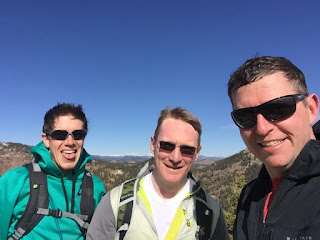 |
| Lost Creek Wilderness |
Overview
Bennett
Mountain is in the Front Range of Colorado. This was my first ascent of Bennett
Mountain, with the closest peak I have reported on being Carpenter
Peak. I don’t assume too many people climb to the summit of Bennett
Mountain, though the access road may get lots of trail runners, hunters, and
snowshoe traffic. The trailhead is a little tricky to get to, so use the
information provided below. This is a fairly short hike and getting to the
trailhead may be more time consuming than the actual climb of the mountain. I
hope you enjoy this trip report and find it helpful in planning your next
adventure in the hills.
Directions/Trailhead Information
The Bennett Mountain Trailhead is located at—latitude
39.367832°, longitude -105.122883°. There is a small parking area that will
accommodate a few vehicles. There are no restrooms at the trailhead. From the
Denver area make your way to the small town of Sedalia. Sedalia is located at
the intersection of US-85 N and CO-67 S. Follow CO-67 S for about 15.3 miles turning right on an unnamed road. Maybe
a hundred feet prior to the turn there will be a roadside sign for the Columbine Public Archery Range. Turn
right (north) following this road till it ends with a gate. The trailhead
parking area is also used for the archery range. The side road from CO-67 S is a dirt road that is in good
condition and is accessible for all vehicles.
The Climb
This is a
short climb, at about 3.5 miles round trip that follows a closed off road for
the majority of the hike. So basically, this isn’t an ideal climb in the
mountains for me, but my good friend Brian was in town and asked if we could
get out on a mountain. From the trailhead there is a closed off road heading to
the north. Follow this road till you get to the following coordinates: 39.383572°
latitude, -105.128160° longitude. This is at a major bend in the road where the
road starts trending to the northwest. An unofficial trail leading to the
northwest can be spotted that will lead you to the summit of Bennett Mountain.
To be
honest, this is a climb that will barely be enough to get your heart rate up,
but there are some nice views of the Lost Creek Wilderness. After a frosty
beverage at the summit we headed back on the same route we took to the summit.
Parting Notes
A nice short
hike, that would be a good intro or starter hike for the season. This would be
a nice family place if you would like your kids to run around a bit. I’ll bring
my family back here in the summer months for a family outing. Until next time,
cheers!
 |
| GPS Track |
Date: October
23, 2016
Trailhead
Elevation: 7,646 feet
Bennett
Mountain: 8,022 feet
Total
Ascent: 430 feet
Class: 2
Distance: 3.5
miles
Moving Time:
1 hr 8 min
Stopped
Time: 0 hr 24 min
Climbing
Partners: Brian
GAIA GPS
Link: Bennett
Mountain (2016-10-23)



































